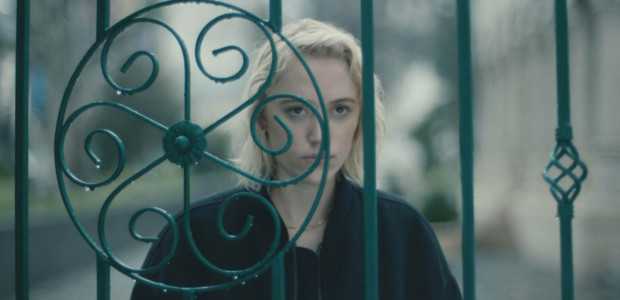There is an unspoken social contract with regards to apartment building windows: they’re intended to be looked out of, and not looked into. Yet looking out of them often reveals other windows to be peered into, and with that comes both the thrill of illicit voyeurism and the fear of being perceived. While Chloe Okuno’s WATCHER, upon its Sundance 2022 premiere, is easy to compare to Alfred Hitchcock’s classic REAR WINDOW (1954), the comparison is a bit erroneous. REAR WINDOW sees its protagonist involve himself in the activities of his close neighbors, the film eventually punishing him for his transgression of voyeurism, whereas WATCHER’s heroine, Julia (Maika Monroe), is the one being watched at first. The film is the flip side of REAR WINDOW’s brand of paranoia, where Julia knows she’s being menaced but can’t find a way to prove it or stop it. Julia isn’t a voyeur punished for breaking that social contract, but a woman whose intuition allows her to see a threat that everyone else around her is blind to see, especially the men in her life.
How Julia comes to that revelation and what she does about it are part of what makes WATCHER such a compelling and eerie thriller. Julia is brought to Bucharest, Romania by her new husband, Francis (Karl Glusman), whose recent promotion at his job has landed him in the country of his ancestry. A sometime actress between gigs, Julia at first plays the role of at-home wife, but soon finds her days in a foreign country where she doesn’t speak the language to be crushingly lonely. Left to her own devices, her attention is caught by the citywide state of fear over a mysterious rash of serial murders of women by a killer dubbed “the Spider” by the media, and in that state of worry she first notices a male figure staring at her in her apartment every night. Soon, she begins seeing the man during the day as he seems to be stalking her during her routine. After her suspicions are dismissed by both her husband and the authorities, she starts to take matters into her own hands, attempting to do her own following of the man and see if she can get enough evidence on him to at least convince him to leave her alone. Unfortunately, the man, Weber (Burn Gorman), uses her efforts to make a case to the police for her harassing him, further complicating Julia’s quest and confusing her suspicions.
More than REAR WINDOW, WATCHER feels like a mash-up of a Roman Polanski “woman alone in her apartment” paranoia horror (1965’s REPULSION and 1968’s ROSEMARY’S BABY, to name the most prominent two) and a gaslighting thriller, a la Joe Dante’s THE ‘BURBS (1989). Okuno, making her feature film debut after a series of impressive shorts, expertly ekes every bit of tension from each scene, creating a mood of discomfort that makes even the tiniest moment ominous and unsettling. There’s nothing especially surprising or original in the film’s plot, but Okuno and co-writer Zack Ford aren’t attempting to subvert expectations or make meta-commentary on the genre. Rather, they’re making an exercise in craft, and with WATCHER, as with her previous shorts, Okuno once again proves herself a master of pace and timing. She takes hoary stock moments such as a slow walk down a creepy hallway and infuses them with such menace that the ultimate payoffs that follow are deeply satisfying. Composer Nathan Halpern helps her by never overdoing it with his score, instead providing an excellent sonic bed of dread for such setpieces. Other horror directors working today tend to merely mimic John Carpenter or Wes Craven in these types of scenes with diminishing returns — Okuno makes them feel fresh again.
That’s not to say that WATCHER is devoid of social commentary — far from it, in fact. The film is told completely from Julia’s perspective, and in more ways than one. Cinematographer Benjamin Kirk Nielsen keeps the film within a muted, almost black and white palette, a choice which highlights not only the noirish and gothic elements of the film but also the Bucharest landscape. There are very selective pops of color throughout, and the most prominent one is red, the first instance of which turns up on the cape of a little vampire figurine that Julia buys for Francis. That item acts as a clever red herring, the film feeling like it might actually be about a vampire before the man following Julia turns up on a store’s security camera. Even then, Nielsen and Okuno keep the man’s figure and face disturbingly obscured, furthering the idea of the film visually reflecting Julia’s perspective. Her perspective is also seen in the way Okuno leaves off virtually all subtitles of the frequent Romanian dialogue, putting us in Julia’s place as she’s further isolated, especially from her husband and his work friends as they talk over and around her. In this way, Julia’s quest to out her stalker, prove his guilt and stop his crimes isn’t just an act of altruism or survival, but a way for her to finally and conclusively be heard. Or, in keeping with the major theme and title of the movie, to be fully seen. Unlike Hitchcock and REAR WINDOW, Okuno isn’t attempting to subtly indict the audience of her film in the act of viewing the movie, yet there is a sly irony that one of the most watchable movies of 2022 is one called WATCHER where Okuno uses her audience’s sight against them several times. Seeing is believing, as the saying goes, but WATCHER makes a case for pure instinct to be an important part of that belief.
Tags: Benjamin Kirk Nielsen, Burn Gorman, Chloe Okuno, Horror, Karl Glusman, Maika Monroe, Nathan Halpern, Sundance, Sundance Film Festival, Tudor Petrut, Zack Ford




No Comments